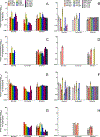Occurrence and Risks of Per- and Polyfluoroalkyl Substances in Shellfish
- PMID: 36255596
- PMCID: PMC9841895
- DOI: 10.1007/s40572-022-00379-z
Occurrence and Risks of Per- and Polyfluoroalkyl Substances in Shellfish
Abstract
Purpose of review: Per- and polyfluoroalkyl substances (PFAS) are a diverse class of persistent, fluorinated surfactants used widely in industrial and commercial applications with known adverse health effects. Seafood consumption is thought to be an underappreciated source of PFAS exposure in the general population. This review synthesizes the current understanding of PFAS occurrence in shellfish, a term used to describe animals such as mollusk bivalves, certain gastropods (snails), cephalopods (e.g., octopuses and squid), and crustaceans, and highlights scientific gaps relative to bioaccumulation and the protection of shellfish consumers.
Recent findings: A range of sampling methodologies are used across studies, and the suite of PFAS surveyed across studies is highly variable. Concentrations of PFAS observed in shellfish vary by geographic location, shellfish species, habitat, and across PFAS compounds, and studies informing estimates of bioaccumulation of PFAS in shellfish are extremely limited at this time. This review identifies several important opportunities for researchers to standardize PFAS sampling techniques, sample preparation, and analytical methodologies to allow for better comparison of PFAS analytes both within and across future studies. Increasing the range of geographic locations where samples are collected is also a critical priority to support a greater knowledge of worldwide PFAS contamination. When put into the context of risk to consumer, concentrations of PFAS, especially PFOS, found in shellfish collected from sites containing aqueous film-forming foam (AFFF) and industrial contamination may present risks to frequent consumers. Further research is needed to protect shellfish consumers and to inform shellfish advisories and health protective policies.
Keywords: Bioaccumulation; Food safety; PFAS; Risk assessment; Shellfish.
© 2022. The Author(s), under exclusive licence to Springer Nature Switzerland AG.
Conflict of interest statement
Conflict of Interest
This article does not contain any studies with human or animal subjects performed by any of the authors.
Figures





References
-
- Favreau P, Poncioni-Rothlisberger C, Place B, Bouchex-Bellomie H, Weber A, Tremp J, et al. Multianalyte profiling of per- and polyfluoroalkyl substances (PFASs) in liquid commercial products. Chemosphere. 2017;171:491–501. - PubMed
-
- ITRC. PFAS Technical and Regulatory Guidance Document and Fact Sheets [Internet]. Washington, D.C.: Interstate Technology & Regulatory Council; 2020. Available from: https://pfas-1.itrcweb.org
Publication types
MeSH terms
Grants and funding
LinkOut - more resources
Full Text Sources
Research Materials

